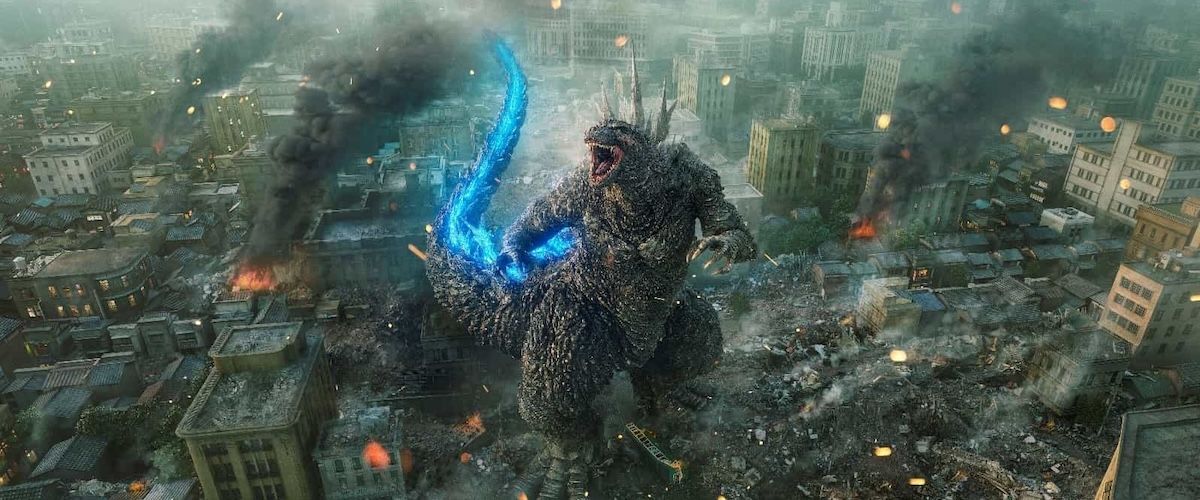Jonah Naplan December 28, 2023
“Godzilla Minus One” is the finest Godzilla movie I’ve ever seen, which is ironic because it’s barely a “Godzilla” movie at all. This film, directed by Japanese filmmaker Takashi Yamazaki, is more or less a commemoration of the beloved kaiju’s 70th birthday coming up next year, and it respects the old man by allowing him space to play and depicting him as the menacing beast he was always meant to be. This is not a film that glamorizes the takedown of Godzilla like those produced by Warner Bros. in the ostentatious Monsterverse. No, this is a movie that allows itself the advantages of time, grief, and life as we know it to make us deeply care about these characters, their losses and their personal victories. What results is a riveting and often emotionally palpable historical drama about real people with real stakes that just happens to have Godzilla in it too.
The movie takes place in the aftermath of World War II in Japan, and it centers on a kamikaze pilot named Koichi Shikishima (Ryunosuke Kamiki), who tries to abdicate his duty by faking a faulty aircraft and landing at a repair site on Odo Island. This opening scene is where we first meet Godzilla—ginormous, powerful, and utterly terrifying—who slaughters most of the island’s army men, partly because the big G is just so talented at eating people, but also because Koichi can’t get himself to actually shoot after he’s laid aim on Godzilla. The burden of those many deaths will sit with him for the remainder of the movie, heightened by his fellow surviving soldiers’ constant reminders that the deceased’s fate was in his hands. Returning to his ruined city, Shoichi settles down with a nuclear family of sorts—“wife” Noriko (Minami Hamabe) and “daughter” Akiko (Sae Nagatani), a young girl whom Noriko saved from the clutches of war and now swears to protect. The trio has a clumsy start, but with time Shoichi learns to love them, driven by his desire to keep them safe. When Godzilla strikes another metropolitan city, obliterating everyone and everything in his relentless path, ultimately devastating the entire population, Shoichi and a motley crew of scientists, engineers, and ex-military operatives band together to formulate a plan to take Godzilla down for good.
Despite featuring a massive creature who’s obviously rendered in heavy CGI and who can topple over buildings with a flick of his tail and cause exponentially more damage when he unleashes his atomic heat breath, “Godzilla Minus One” is one of the most human stories I’ve seen this year. It wallows around in themes of regret, longing, and vengeance, and earns every single minute of it. That’s not to say this is a slow movie at all, in fact, it’s very far from one. Running briefly over two hours, “Godzilla Minus One” feels about forty minutes shorter than it is, which is impressive considering how many scenes unfold entirely in dialogue, grappling with ideas you wouldn’t typically expect to see anywhere near a monster movie. Granted, “Godzilla Minus One” reaches a point where it’s barely a “monster movie” anymore, as nothing about it is that monster-y other than it occasionally features a monster.
The performances in this film don’t feel modern, as if they were plucked from an earlier decade and dropped right into this one. Kamiki, in particular, seems to be channeling the acting techniques of stars from the 50s and 60s who discovered that the audience can detect emotional vulnerability (which is often good) as long as you physically open yourself up to the camera in ways that can only be depicted in a motion picture. But all the supporting players display a similar effect; a couple of colleagues played by Hidetaka Yoshioka and Munetaka Aoki are notable in their eccentricity and buoyant showcase of ideas, the former surmising the entire strategy by which the team abides by, and the latter being the team’s savior who swoops in just in the nick of time to repair Shoichi’s plane; and Hamabe is poignantly sincere but not to such an extreme degree that she becomes the movie’s emotional prey—we become attached not because the film forces us to but because it comes naturally.
But, of course, the real MVP is Godzilla himself, who smashes and crashes his way around city landscapes to little consequence, until Shoichi delivers the goods in the third act. Godzilla was born to be a menacing force, and this is a movie that finally knows it. It’s easy to forget that this Godzilla isn’t actually real, despite its mechanical cartoonishness, but that might just be because the characters that surround him (or flee from him) feel so tangible, like we can reach out and touch them.
“Godzilla Minus One” reckons with the humanity of Godzilla by exiling him to such a furious, unforgiving state, where each hit he takes only seems to make him angrier and stronger. It’s almost, but only almost, as if he, too, is a grieving soldier in the body of a big reptile, motivated and made even hungrier to keep fighting by each hurdle he comes across. “Godzilla Minus One” is so simple on a surface level that it leaves all that perspective room open for interpretation and inquiries, things that cannot be explicitly proven unless you speak directly with the screenwriter (also Yamazaki), or concoct a video essay that dissects those claims and explores how they’re supported by the events of the film.
Nothing is certain. The only thing we can confirm is that there’s no Godzilla without the people, and if they can believe in such a beast, well, so can we.
Now playing in theaters.

